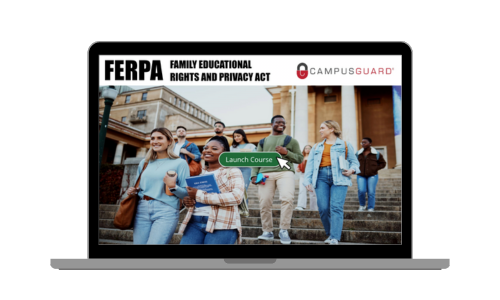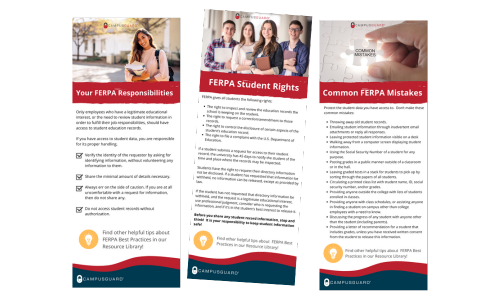FERPA Course Description
This course provides an overview of the Family Educational Rights and Privacy Act (FERPA) and the laws governing acceptable use and release of student education records.
- Target Audience: All faculty/staff with access to student records
- Course Length: 25 minutes
FERPA Course Learning Objectives
CampusGuard’s FERPA course provides an overview of the key protections under FERPA, reviews individual staff and faculty responsibilities, and guides how to protect students’ right to privacy, and explains the potential consequences of non-compliance.

FERPA Course Modules
Our FERPA course is designed with micro-learning modules, making the content easier to retain. This course is designed to help your organization and staff safeguard sensitive personal information and prevent potential data breaches.
-
Family Educational Rights and Privacy Act
This module provides an overview of the Family Educational Rights and Privacy Act (FERPA) and the laws governing the acceptable use and release of student education records. -
Common Scenarios
This module discusses several different scenarios in which a faculty or staff member may be requested to share student information. Users must review the situations carefully and select the appropriate answer. Training provides a comprehensive explanation to help guide users in their FERPA awareness.
 Explore our other courses
Explore our other courses
Explore our full course library to find training that fits your needs, from security awareness and compliance essentials to specialized topics designed to support your role and responsibilities. Whether you’re looking to strengthen your cybersecurity posture, stay up to date with industry regulations, or broaden your knowledge, we’ve got you covered.
The Latest FERPA Course Updates
- Directory information
- Artificial Intelligence and FERPA
- Third-party risks
- Compliance and enforcement
- Data breaches
- Recent lessons learned
- Common scenarios
- Examples of violations
Access Our Resource Library and Threat Intel News
All FERPA Course users also have access to our Resource Library, which offers supplemental materials that support the course content.
Our Threat Intel Briefing newsletter is sent directly to your inbox twice a month, and features the latest cyber threats, cyber crimes, and vulnerabilities happening now around the globe.

Related Products and Services
Protecting Student Data and Privacy
CampusGuard’s FERPA training course empowers staff with actionable strategies to safeguard student data and prevent unauthorized access. This training helps reduce the risk of data breaches by reinforcing privacy best practices.


